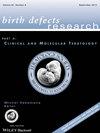中国躁狂症和躁狂症流行病学特征及时间趋势。
Q Medicine
Birth defects research. Part A, Clinical and molecular teratology
Pub Date : 2016-02-01
DOI:10.1002/bdra.23462
引用次数: 43
摘要
背景:以往的研究表明,躁狂症和小症的患病率时间趋势不一致。关于中国人群中躁狂症和躁狂症的流行病学特征报道甚少。方法1996-2007年的数据来自中国出生缺陷监测网络。根据人口学特征和年时间趋势评估出生时厌食症和小症的患病率。使用泊松回归计算选定的人口学特征和躁狂症和躁狂症亚组的粗患病率和校正患病率(APRs)以及95%置信区间(ci)。结果在6308594例活产、死产和终止妊娠中,共发现了1933例躁狂症/躁狂症,发生率为3.06 / 10000例。孤立性厌食症/小症的患病率为每1万例出生2.25例,而在非孤立病例中,患病率为每1万例出生0.81例。1996 ~ 2007年,躁狂症/小症患病率明显增高(p < 0.05)。西部出生的新生儿中,孤立性厌食症/小症的出生患病率显著较高(APR, 1.24;95% CI, 1.10-1.40),居住在城市地区的母亲(APR, 1.29;95% CI, 1.15-1.46),母亲年龄大于35岁(APR, 1.26;95% CI, 1.01-1.57),男性(APR, 1.38;95% ci, 1.24-1.53)。未观察到非孤立性厌食症/小症与地理区域、母亲居住地和婴儿性别(母亲年龄除外)之间的显著关联。结论中国新生儿躁狂症和小症患病率呈上升趋势。在西部出生、居住在城市地区的母亲、年长母亲和男性中,发现孤立性躁狂症和小症的流行风险较高。本文章由计算机程序翻译,如有差异,请以英文原文为准。
Epidemiologic characteristics and time trend in the prevalence of anotia and microtia in China.
BACKGROUND
Previous studies have shown an inconsistent time trend on the prevalence of anotia and microtia. Little has been reported on the epidemiologic characteristics of anotia and microtia in the Chinese population.
METHODS
Data from 1996-2007 were obtained from the Chinese Birth Defects Monitoring Network in China. Birth prevalence of anotia and microtia were assessed according to demographic characteristics and annual time trend. Poisson regression was used to calculate crude and adjusted prevalence ratios (APRs) and 95% confidence intervals (CIs) for selected demographic characteristics and subgroups of anotia and microtia.
RESULTS
A total of 1933 cases with anotia/microtia were identified among 6,308,594 live births, stillbirths, and terminations of pregnancy, yielding a rate of 3.06 per 10,000 births. Isolated anotia/microtia had a prevalence of 2.25 per 10,000 births, whereas among nonisolated cases, the prevalence was 0.81 per 10,000 births. The prevalence rates of anotia/microtia increased significantly during 1996-2007 (p < 0.05). Birth prevalence of isolated anotia/microtia was significantly higher among western births (APR, 1.24; 95% CI, 1.10-1.40), mothers residing in urban areas (APR, 1.29; 95% CI, 1.15-1.46), mothers more than 35 years of age (APR, 1.26; 95% CI, 1.01-1.57), and males (APR, 1.38; 95% CI, 1.24-1.53). No significant associations were observed between nonisolated anotia/microtia and geographic areas, maternal residence, and infant sex (except for maternal age).
CONCLUSION
An increasing trend of the birth prevalence of anotia and microtia is observed in China. Higher prevalence risk of isolated anotia and microtia is found among western births, mothers residing in urban areas, older mothers, and males.
求助全文
通过发布文献求助,成功后即可免费获取论文全文。
去求助
来源期刊

Birth defects research. Part A, Clinical and molecular teratology
医药科学, 胎儿发育与产前诊断, 生殖系统/围生医学/新生儿
CiteScore
1.86
自引率
0.00%
发文量
0
审稿时长
3 months
 求助内容:
求助内容: 应助结果提醒方式:
应助结果提醒方式:


